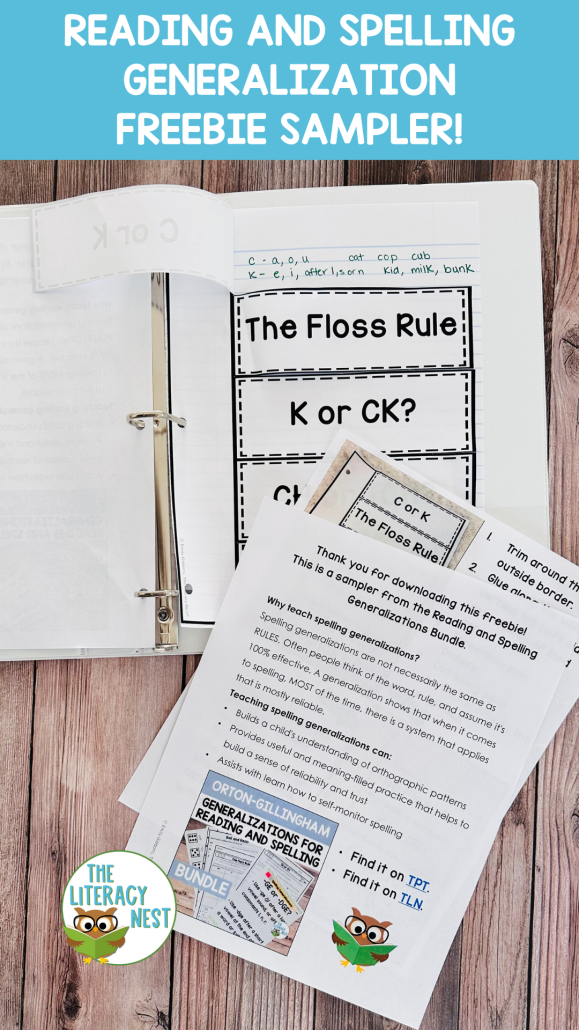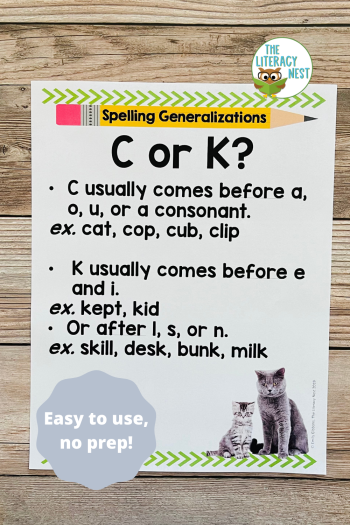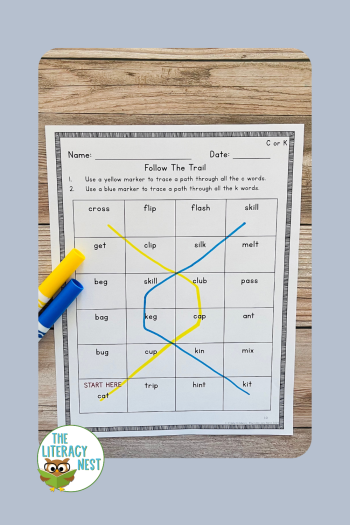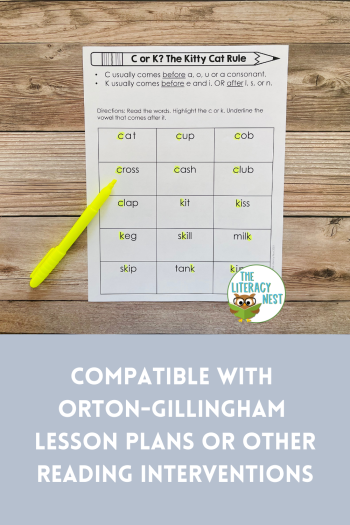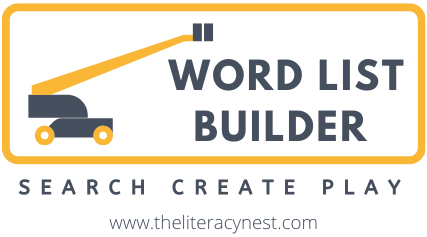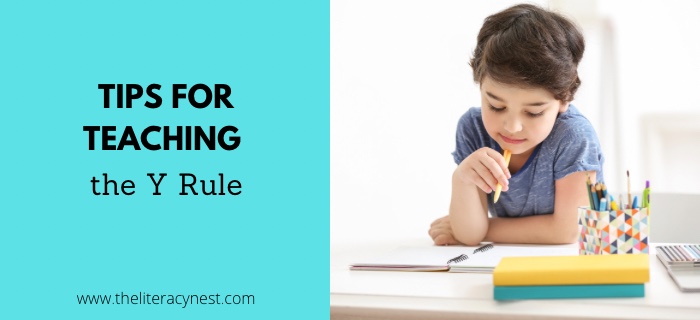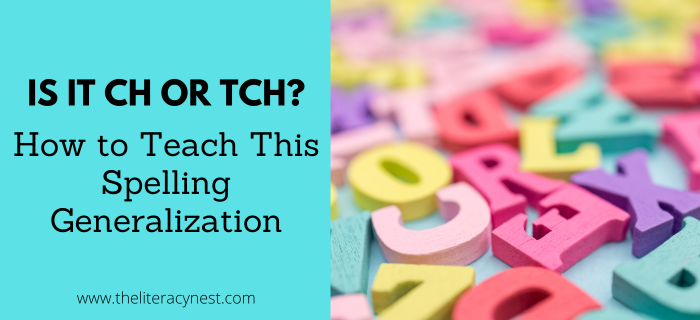Is it C or K? How to Teach This Spelling Generalization
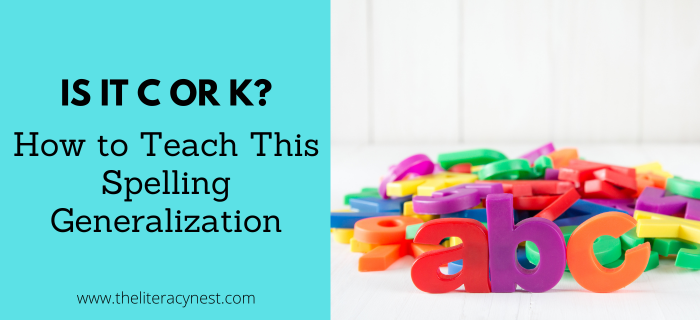
Does it start with c or k?
A simple spelling generalization that students find very empowering regards the spelling of the initial /k/ sound or when the /k/ sound is part of an initial blend. Students are usually aware that ck is not found at the beginning of a syllable, but they often aren’t aware of how to decide whether to use c or k.
The Kitty Cat Rule
This generalization says that when the /k/ sound is followed by i, e, or y it is spelled with a k. The rest of the time it is spelled with a c. There are some rhymes to help such as “k takes I and e, c takes the other 3” (meaning the 3 other vowels) but this rhyme, while catchy, is incomplete. “k takes I, e and y, c takes everything else” is more accurate but less memorable.
Some words that follow this generalization include:
Cat crust clog cub camera kiss Kevin
It is helpful to be sure to consider this rule not only for the very beginning of words but for other syllables or as part of blends.
For example in the words:
Focus ridicule fact scarf skin
Some words that don’t follow this generalization include:
Although this spelling generalization applies much of the time, there are a few notable exceptions, including:
Skunk Kate skate koala kangaroo Korea
Kung fu skull Kansas
In order to teach this generalization, it is helpful for students to:
- know closed syllables and blends.
- be able to segment 4 or 5 sounds.
Tips for Teaching C or K:
It is probably best to teach this generalization early on with e and i and then revisit it after teaching the vowel sounds for y. In addition, I like to teach the Kitty Cat rule BEFORE I get into VCe syllable types because they will have to make the C or K grapheme choice quite a bit when encoding VCe words, particularly the word cake.
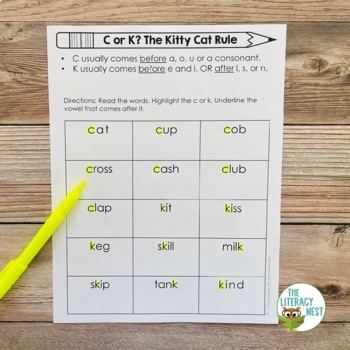
Want even more ways to practice spelling generalizations? Read 5 Fun and Easy Ways to Practice Spelling Generalizations!
Students can use some guiding questions to help them make a decision when writing a new word:
- What sound do I hear after /k/?
- Is this sound a consonant or a vowel?
- If the sound is a vowel, which vowel is it?
Download this printable guide for teaching the Kitty Cat Rule!
Download our Reading and Spelling Generalizations freebie sampler! It includes mini posters, a note-taker, and a handy cheat sheet with links to blog posts and a video with teaching tips!
Fun teaching ideas for The Kitty Cat Rule:
1. Using a Dictionary to Introduce
It is often helpful for students to understand that c is a much more common spelling for /k/ at the beginning of a syllable than k. It is a fun and surprising activity for many children to pull out a dictionary with the guidance of an adult, and simply count the number of pages for words that begin with c and for words that begin with k. The difference whether you are using a children’s dictionary or a collegiate dictionary is remarkable. When in doubt, children can know that c is a more likely choice even if they have forgotten the rule.
2. Sorting
You can sort words by spelling or sort pictures by vowel sounds to build phonemic awareness skills and to build orthographic mapping skills.
3. Start from the known
Using words that students know how to read and spell can help to introduce and reinforce this rule.
4. Review activities
Spending just a couple of minutes each lesson working with this generalization will help to solidify the learning. Have the student fill in the blank with c or k to finish spelling words. Ask them to segment a word into its sounds using counters or blocks and decide whether to use c or k.

5. Dictation
Make sure to avoid using c and k words in dictation (after both of them have been taught) until you have taught this generalization. Avoid using exceptions to this spelling generalization in writing, although it is helpful to familiarize students with these words through reading.
6. Games
Play games where the student not only needs to read but actually make spelling choices between c or k. Make a word list that includes words with c and k. Have the student spell a word. If they are able to spell the word correctly, they can roll a die and move along a game board. This basic principle can be adapted in a number of ways. Play c or k Jenga, Don’t Break the Ice, or any of the other repurposed games in your collection. Even Go Fish or Concentration can be presented with a spelling twist.
7. Spiral and Review
I recommend reviewing this spelling generalization before teaching other spelling generalizations involving the /k/ sound. I find that connecting their knowledge about spellings of /k/ together builds a more solid understanding.
Incorporating c/k practice into SOS review words is an excellent way to keep this learning fresh with the previously mentioned cautions. If there are few concepts needing intensive review, cycling through spelling generalizations is always an appropriate review.
As new learning is added to your student’s repertoire, especially with multi-syllable words, it is helpful to review this learning.
8. Verbalize
It is very valuable to have students explain the spelling generalization in their own words. Another way to encourage students to have a deep understanding and ability to explain the generalization is to ask them why they made the spelling choice that they did. For example, in the word class, you could ask the student why they used c, or WHY they chose to use k in the word kettle or kiss. This will often expose any misunderstandings or areas that need clarification. Asking a child to verbalize WHY they spelled a word a certain way helps to solidify their understanding and builds metacognition.
Teaching and practicing this spelling generalization will not only provide students with learning differences a valuable tool for spelling, but also through many repetitions of correct spelling with the aid of this guideline, build a repertoire of known words and an overall orthographic awareness.
For more on spelling generalizations, check out these excellent and informative blog posts!
C or K? The Kitty Cat Rule
If you are looking for systematic and explicit phonics instruction, we’ve got you covered! This resource teaches the spelling generalization C or K. It is compatible with Orton-Gillingham lesson plans, dyslexia intervention, and other reading interventions.
You can grab it in The Literacy Nest Shop or on TpT.
Download this FREEBIE for C or K practice. And, if you are seeking more advanced practice, check out this Spelling Generalizations bundle.
Are you looking for a list of words that follow the Kitty Cat Rule? Word List Builder has got you covered!
Save time searching for words that follow the Kitty Cat Rule! Create customized and meaningful review, build your folder of words, create templates and games, and much more in Word List Builder.


